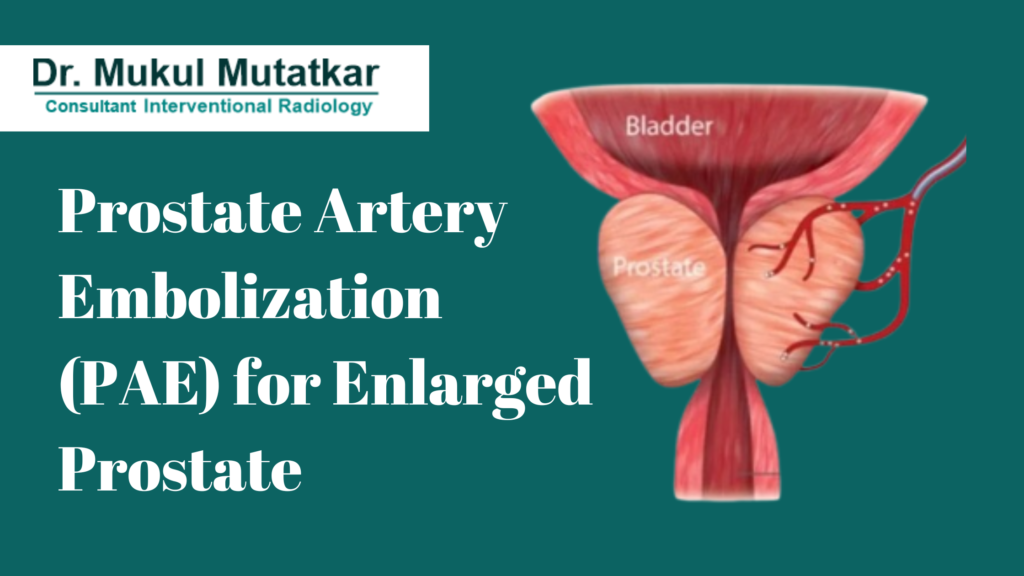Enlarged prostate, also known as Benign Prostatic Hyperplasia (BPH), is a common condition among men, especially those above 50 years of age. This condition leads to urinary issues such as frequent urination, weak urine flow, and incomplete bladder emptying. Traditionally, surgery was the primary treatment option for severe BPH. However, advancements in medical technology have introduced Prostate Artery Embolization (PAE) as a minimally invasive and highly effective alternative to surgery.
What is Prostate Artery Embolization (PAE)?
Prostate Artery Embolization (PAE) is a non-surgical procedure performed by interventional radiologists to treat an enlarged prostate. It involves blocking the blood supply to the prostate, leading to shrinkage and symptom relief. Unlike traditional surgical methods, PAE does not require general anesthesia, and patients experience faster recovery and fewer complications.
How Does PAE Work?
- Consultation and Diagnosis: Before the procedure, the doctor conducts a detailed evaluation, including imaging tests like MRI or angiography, to assess the prostate and blood vessels.
- Procedure: A tiny catheter is inserted through the groin or wrist and guided to the arteries supplying blood to the prostate.
- Embolization: Microscopic particles are injected into the arteries to block blood flow, reducing the prostate’s size over time.
- Recovery: The procedure typically takes 1-2 hours, and most patients can go home the same day with minimal discomfort.
Benefits of Prostate Artery Embolization
- Minimally Invasive: No large incisions or stitches are required.
- Quick Recovery: Most patients resume normal activities within a few days.
- Preserves Sexual Function: Unlike some surgical options, PAE has a lower risk of causing erectile dysfunction or urinary incontinence.
- Effective and Long-Lasting: Studies show significant improvement in urinary symptoms within a few weeks, with long-term relief.
- Lower Risk of Complications: No need for general anesthesia reduces potential surgical risks.
Who is an Ideal Candidate for PAE?
PAE is recommended for men who:
- Have moderate to severe symptoms of BPH.
- Prefer a non-surgical treatment option.
- Are not suitable candidates for surgery due to other health conditions.
- Wish to avoid side effects like sexual dysfunction and urinary incontinence.
Why Choose Prostate Artery Embolization in Pune?
If you are looking for an advanced, non-surgical solution for BPH, opting for Prostate Artery Embolisation in Pune ensures you receive expert care. Pune is home to highly qualified interventional radiologists who specialize in this state-of-the-art procedure. With top-notch medical facilities and the latest technology, patients can expect safe, effective, and comfortable treatment.
Finding the Right Interventional Radiology Clinic in Pune
Choosing a trusted Interventional Radiology Clinic in Pune is essential for a successful PAE procedure. The right clinic will offer:
- Experienced interventional radiologists trained in performing PAE.
- Advanced imaging technology for precise and safe procedures.
- Comprehensive pre- and post-procedure care to ensure the best outcomes.
Post-Procedure Care and Recovery
- Mild Discomfort: Some patients experience mild pelvic pain, which subsides within a few days.
- Hydration is Key: Drinking plenty of water helps flush out embolization particles.
- Gradual Improvement: Urinary symptoms typically improve within a few weeks to months.
- Follow-Up Appointments: Regular check-ups ensure the prostate is shrinking as expected.
Conclusion
Prostate Artery Embolization (PAE) is revolutionizing the treatment of enlarged prostate by offering a safe, effective, and minimally invasive alternative to surgery. With Prostate Artery Embolisation in Pune, patients can benefit from expert care and cutting-edge medical technology. If you or a loved one is struggling with BPH symptoms, consulting an Interventional Radiology Clinic in Pune can help you explore this innovative treatment option.
For more information, consult a specialist today and take a step toward better prostate health!

